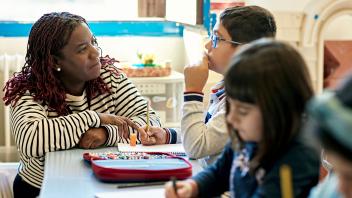Key Takeaways
- How to vary the level of content you present
- How to provide a variety of learning environments
- Different ways students can show what they've learned
At its most basic level, differentiation consists of the efforts of teachers to respond to variance among learners in the classroom. Whenever a teacher reaches out to an individual or small group to vary his or her teaching in order to create the best learning experience possible, that teacher is differentiating instruction.
Teachers can differentiate at least four classroom elements based on student readiness, interest, or learning profile:
- Content – what the student needs to learn or how the student will get access to the information;
- Process – activities in which the student engages in order to make sense of or master the content;
- Products – culminating projects that ask the student to rehearse, apply, and extend what he or she has learned in a unit; and
- Learning environment – the way the classroom works and feels.
Content
Examples of differentiating content at the elementary level include the following:
- Using reading materials at varying readability levels;
- Putting text materials on tape;
- Using spelling or vocabulary lists at readiness levels of students;
- Presenting ideas through both auditory and visual means;
- Using reading buddies; and
- Meeting with small groups to re-teach an idea or skill for struggling learners, or to extend the thinking or skills of advanced learners.
Process
Examples of differentiating process or activities at the elementary level include the following:
- Using tiered activities through which all learners work with the same important understandings and skills, but proceed with different levels of support, challenge, or complexity;
- Providing interest centers that encourage students to explore subsets of the class topic of particular interest to them;
- Developing personal agendas (task lists written by the teacher and containing both in-common work for the whole class and work that addresses individual needs of learners) to be completed either during specified agenda time or as students complete other work early;
- Offering manipulatives or other hands-on supports for students who need them; and
- Varying the length of time a student may take to complete a task in order to provide additional support for a struggling learner or to encourage an advanced learner to pursue a topic in greater depth.
Products
Examples of differentiating products at the elementary level include the following:
- Giving students options of how to express required learning (e.g., create a puppet show, write a letter, or develop a mural with labels);
- Using rubrics that match and extend students’ varied skills levels;
- Allowing students to work alone or in small groups on their products; and
- Encouraging students to create their own product assignments as long as the assignments contain required elements.
Learning environment
Examples of differentiating learning environment at the elementary level include:
- Making sure there are places in the room to work quietly and without distraction, as well as places that invite student collaboration;
- Providing materials that reflect a variety of cultures and home settings;
- Setting out clear guidelines for independent work that matches individual needs;
- Developing routines that allow students to get help when teachers are busy with other students and cannot help them immediately; and
- Helping students understand that some learners need to move around to learn, while others do better sitting quietly (Tomlinson, 1995, 1999; Winebrenner, 1992, 1996).
Excerpted from: Tomlinson, C. A. (August, 2000). Differentiation of Instruction in the Elementary Grades. ERIC Digest. ERIC Clearinghouse on Elementary and Early Childhood Education.
